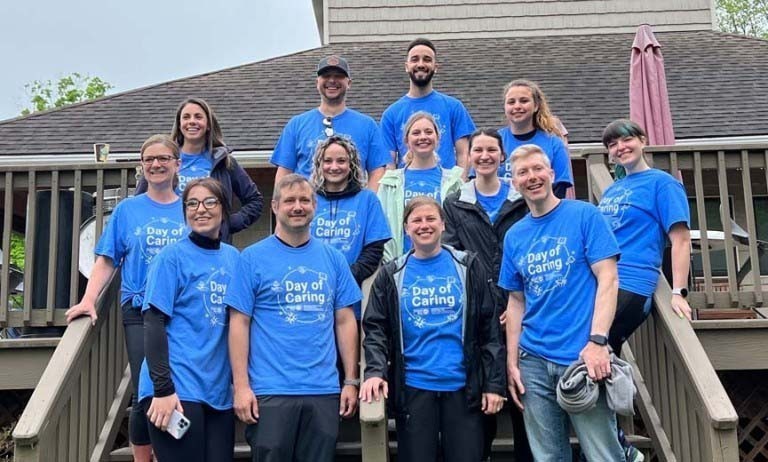- Recursos humanos
- Artículo
- Lectura de 6 minutos
- Last Updated: 01/06/2023
Starting an Employee Volunteer Program at Your Company

Table of Contents
If you're thinking of starting an employee volunteer program at your company, you're not alone. In our post-pandemic world, where employees and job candidates alike have shown a marked interest in giving back to the community, many businesses are opting for programs that allow employees to participate in volunteer opportunities that build on that interest.
According to the Society for Human Resource Management, a recent survey of HR professionals showed that nearly 50% of U.S. companies offered corporate volunteer programs in 2022, up almost 10% from 2014. Businesses are clearly seeing the value in starting and promoting volunteer programs within their organizations.
What Is an Employee Volunteer Program?
Corporate employee volunteer programs are known by several different names, including corporate volunteer programs and company volunteer programs. Simply put, this type of program is designed to bolster a business's engagement with the community and/or raise its corporate social responsibility profile. Generally speaking, these programs grow out of a concerted strategic initiative designed to support employees who want to give back to the communities in which they live.
What Are the Benefits of Employee Volunteer Programs?
The organizational benefits to starting an employee volunteer program are significant. These include higher brand awareness among the community in which a business is located, and more opportunities to promote the business as an "employer of choice," thus increasing appeal to job candidates.
With employee volunteering, there are numerous internal benefits as well. These may include:
- Enhanced employee retention
- Increased sense of employee empowerment
- Greater employee pride in the business where they work
- Strengthened teams, where groups of employees volunteer together
- Employees gaining new skills and perspectives
How To Start a Volunteer Program at Work
Determining the best way in which to initiate an employee volunteer program may depend on individual company cultures. But certain key steps should include some part of the following:
Gather Employee Input
The most effective corporate volunteer programs start with employers soliciting feedback from employees about how best to structure the program. One option is conducting a survey concerning employees’ preferred charitable institutions, and whether they wish to volunteer their time, donate money, or some combination of both. You can also determine whether some employees are already volunteering in some charitable function. It might be beneficial to explore partnering with a non-profit organization in which some employees are already volunteering their time and effort.
Determine the Program's Core Purpose and Values
Corporate volunteer programs should incorporate a business's core purpose and values into the planning and execution process. It's essential that the type of program undertaken is firmly aligned with what the company stands for. This approach helps determine what kind of volunteer opportunities make the most sense for the organization to pursue and can also deepen the employees' sense of purpose and involvement in the program.
Establish Goals and Employee Volunteer Program Guidelines
Like any other corporate initiative, the design of employee volunteer and engagement programs should have clear, concrete goals. Those frequently cited by companies with successful volunteer programs often include:
- Giving back to the community
- Enhancing the company's brand
- Boosting employee engagement and retention
- The number of employees who can participate in a volunteer program
- How many hours a business can comfortably accommodate in terms of employee participation
- Financial objectives for fundraising through volunteer efforts
Recruitment is another key goal for work volunteer programs. It's often said that millennials put a high value on companies with an established profile in social responsibility. Jobseekers increasingly want to work for an organization that demonstrates awareness of social conditions and helps to make life better for the local community. Once it's underway, your volunteer program may contribute to a promising job candidate's interest in applying for open positions with your organization.
Document Your Program Development
It's not enough to simply say, "Yes, we should start a volunteer program at our company." To be successful, carefully document the corporate volunteering program as it gets underway, as well as which elements contribute to the program’s success and those that prove to be ineffective (so as avoid those missteps in future employee volunteer program guidelines).
As your employee program starts to take shape, take care to document:
- Communicating news of the volunteer program to employees
- Costs incurred in the design and roll-out of the program
- Levels of enhanced brand awareness on social media and other platforms
- Increase in candidate recruitment, once the program is underway
With a list of relevant metrics in mind, it becomes easier to track the effects of your employee volunteer program. This method also helps facilitate any future attempts to broaden those volunteer efforts or to strike out in a different community outreach effort in the future.
Support the Program Through Leadership and Company Resources
A valuable component of any effective volunteer program starts with support from the CEO and other senior-level executives. Serving as role models, these individuals can inspire team members to become active participants in such a program. Leaders can also find the right balance between the organization's business goals and issues facing the local community.
The human resources team also plays an integral role in the design and structure of a volunteer program. HR can help align business needs with the spirit of volunteerism that is essential for the program's success. They can also determine how best to incorporate volunteer activities within both the veteran employee pool and the new hires. HR can also help decide upon the best ways to encourage employee participation in the program.
It's a good idea to consult your legal team prior to establishing a corporate volunteer program. These types of initiatives sometimes have wage and hourly implications, as well as other possible issues.
Finally, employing internal communications to promote volunteer activities is a crucial element. To boost interest in the program, look at all possible internal communications platforms and spread the word in a consistent, clear-cut manner.
Make Volunteer Opportunities Inclusive
To help ensure success, consideration should be given to opening the company volunteer program to all employees, regardless of their status as full- or part-time workers. This should also include remote employees, who may otherwise feel disengaged with the organization if they don't have opportunities to participate in the program and give back to the community. By focusing on inclusivity and the wide range of employee skills and experience, you help ensure the opportunity for all employees to take part.
One tool that can help boost inclusivity is a formal (or informal) employee survey. Gauge the interest of team members — both on-site and off-site — in taking part in volunteer activities. Just make sure everyone within the company can participate in the survey. That way, you'll have a better idea of your employees' volunteer preferences, and avoid the problem of leaving anyone out of the process.
Encourage Participation Through Internal Communications
The success of a corporate volunteer program largely depends upon getting the word out to your workforce. Thankfully, a wide array of communications resources are available for this purpose. These resources can include:
- Internal email campaign
- Fliers and bulletins
- Employee newsletter
- A message from the CEO
Also, it's very helpful to enlist managers in your promotion efforts. Once they are on board with the initiative, encourage them to offer an open-door policy with respect to volunteer participation. Managers can help encourage their team members participation by answering questions and promoting the benefits of volunteerism. If managers are excited about the new program, they will more likely convey that enthusiasm to employees under their supervision.

Share News of Progress
With a volunteer program in place, it's time to single out those who are most engaged and upbeat about the experience. Consult these "program champions" and support their efforts in publicizing the program among their co-workers.
Employee participants can also share news of progress through photos and brief descriptions about their experience. Additionally, survey those who take part and evaluate the level of their satisfaction with the program. Hopefully, the response will be positive, in which case, don't hesitate to share their views with the rest of the organization.
Revise and Revisit Your Volunteer Program on a Regular Basis
Once you have a viable corporate volunteer program underway, there's no time to rest on your laurels. To be genuinely effective, the program should be revisited and reevaluated on a regular basis. Are team members responding favorably to the program? Is participation up or down? Is the effort meeting a pre-determined budget or exceeding costs? Which community non-profits or other organizations should you seek to align with?
One effective barometer of a program's effectiveness is through surveying volunteer participants. Devise a brief survey that includes both "yes" and "no" questions, as well as open-ended questions regarding how well an event succeeded, where parts of that event fell short, and what can be done in the future. This way, you can keep a close eye on the program's viability and outlook for the future.
How To Encourage Corporate Volunteerism
It's one thing to get a company volunteer program up and running. Encouraging participation among employees is something else altogether. Rather than simply establishing a program and sit back waiting for something to happen, it's critical to actively build and support employee interest in this endeavor.
Start by integrating volunteerism into your company culture. This often entails top leadership's involvement, either directly through specific volunteer activities, or by drawing attention to the company volunteer program at every appropriate juncture (emails to the team, encouragement during all-staff meetings, etc.). Also, place volunteerism front and center in the wording of your corporate mission and values, highlight it prominently in recruitment materials, and as part of your new hire onboarding program.
Here are other ways to get employees more involved:
- Provide PTO. Some organizations provide additional paid time off (PTO) to employees who sign up to volunteer. Organizations selecting this option may seek to reduce potential misuse by setting clear expectations for employees who take part in volunteer activities — a specified minimum number of hours, whether it's to be offered to a team rather than individuals, and so on.
- Gift card incentives. Offer the kinds of gift cards employees care most about (resulting from informal surveys) and present those to employees who volunteer the greatest amount of hours, devise new volunteer opportunities, or as a "kick-start" at the program's outset.
- Treat volunteers to lunch. Generally speaking, most volunteer activities will involve the efforts of numerous employees, whether at a single charitable event or as part of an ongoing program. In any case, treating these volunteers to lunch at the company's expense is a way to build team spirit and engagement, particularly among employees who come from different departments but are united by the goal of helping others.
- Enroll volunteers in a prize drawing. Prize drawings are a way of injecting some excitement into the volunteer recruitment process. Look for a high-end prize (for example, a tablet or some other electronic device) that is likely to appeal across the board, rather than a prize that only a small group of people might want. The prize drawing can be held at the end of a volunteer event, as a way of celebrating company involvement.
A volunteer program's eventual success depends largely upon the efforts of leadership to promote involvement. When employees see that volunteerism is now a full-fledged organizational priority, their participation is likely to increase and gain traction as part of the culture.
Examples of Corporate Volunteer Activities
The kinds of volunteer activities your company chooses to pursue depend upon a number of factors — the community's location, civic needs and challenges, opportunities that best align with the organization's values and missions, and so on. Here are popular volunteer activities that may prove most relevant to your own efforts:
- Trash collection. Enlist volunteers in the hard but satisfying job of collecting garbage from a local park or other public area. It's not glamorous work, but citizens living in these areas will greatly appreciate your employees' contributions.
- Food pantry collections. Get volunteers to help collect food for local homeless shelters or other community programs helping those who don't have enough to eat. The same idea can be applied to cooking and serving meals at a shelter or other community outlet.
- Blood drives. Just about every community needs blood donations. Get employees involved in established blood drive programs or see about creating a new one, following a local disaster where hospitals are in short supply of precious blood supplies.
Make Volunteering a Key Element in Your Company's Culture
Getting your business involved in local and national volunteering efforts is a proven way to enhance employee engagement, boost retention, and attract new job candidates. A company volunteer program based on your mission and values will resonate with your workforce and give them new pride in being a part of this larger effort. Brand awareness will grow as a result of successful volunteer efforts, and you'll likely see more non-profits and charitable organizations reaching out to you. All of this translates into your company's favorable image both locally and regionally, and result in greater involvement among your workers and growth in your business.
Tags







